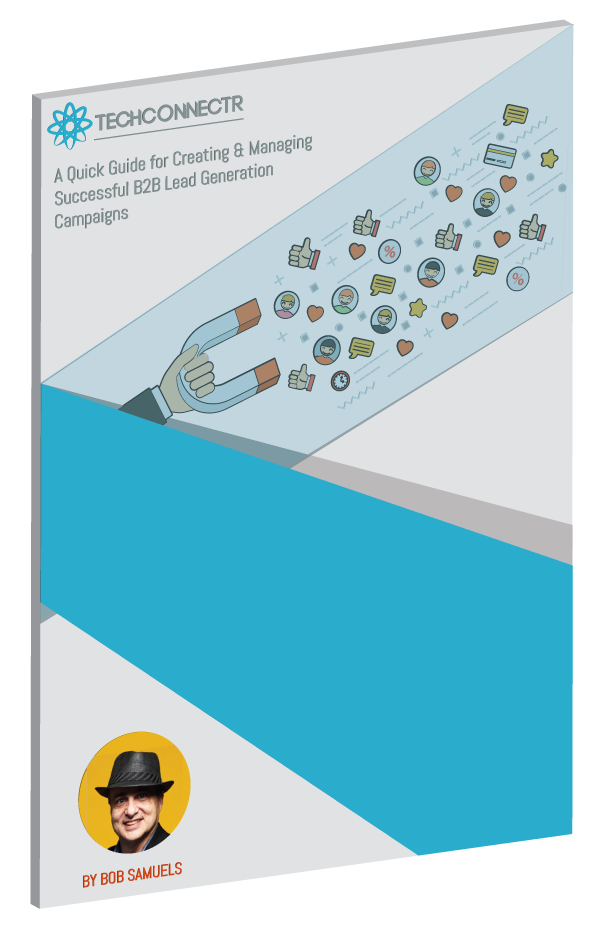Interview with Samantha Stone
Founder & CMO of The Marketing Advisory Network!

Listen to our interview with Samantha and learn what she has to say about:
- Unleash Possible – Samantha’s book – tactics, how-to guidelines on ABM outreach
- Samantha’s background – in economics & sales before marketing
- Marketing Advisory Network – helping companies grow
- ABM approach. How we define the target accounts (aspirational vs scientific based on intent technology)
- ABM approach. Specific media programs which enable outreach to specific companies.
- B2BMX Presentation – Authentic Conversations using Artificial Intelligence – used right, can enhance the human touch
- Virtual Assistants. in combination with human interactions – enhancing, not replacing human interactions
- Artificial Intelligence – human-human conversations listened to by computer – picking up key clues – tone, language
- Drift – chat-bot experience based on who the visitor is. and most importantly, it knows when to hand off to a human
- Using Artificial Intelligence to know when human interaction is valuable and impactful and automated when it is not necessary to talk to a human
- Challenges of using data including natural biases and data collection framework
Check out Samantha’s website and book, Unleash Possible, here.
Click here to read the Video Transcript
Hi this is Bob Samuels I’m founder at Tech
Connector, TechConnector is a marketplace and campaign management
platform a Best of Breed account based marketing solutions we’ve partnered with
the b2b marketing Expo to bring you wisdom from leading account based
marketing thought leaders to that end I’d like to introduce you to Samantha Stone
samantha is founder of the marking advisory network and she’s also author
of unleash possible. Unleash Possible looks like a nice marketing book
Samantha thank you it has really been a wonderful experience writing the book it
was sort of the culmination of you know more than a almost two decades of work
and really writing down you know my my thoughts and concept of how I you know
attack the market and and build go to market plans and things and so but I
wanted it to be you know very how-to driven so each chapter sort of talks
about a concept and then it gives a case study and then it gives a bunch of
how-to guidelines so feedback on it has been really wonderful it’s been a really
valuable tool for me and help sharing how I think about marketing and sales
beautiful beautiful so give it give me a little background your background in
marketing you’ve from from your facebook profile you look really young so you
probably been in here what is your what is your wisdom based on yeah I had
I’ll give you just a very quick history I started actually my career in
marketing completely by mistake so I have a degree in economics and when I
graduated college I was going to save the world through public policy research
I was going to make this huge impact in the world that way the reality is that’s
not a very easy job to find and they really want people right out of school
doing public policy research so while I tried to find myself and started
graduate school I got a job at a software company actually a temporary
job originally they ended up offering me a full-time job and are free and paid
for grad school which I gratefully accepted and and it was my first taste
of technology company and I was actually in the sales division and I spent them
very a few years in channel and partner sales and along the way I was frustrated
by what marketing was providing us so I was doing a lot of my own marketing and
my team was doing her own marketing and eventually I complied complained loudly
enough and hopefully productively enough that they said fine to me I hope you can
do it better a year ago own this and made a transition to marketing and I
fell in love that it was really where I belonged but because of my background in
education and economics and because of my sales experience I always felt that
my marketing was from a different lens I actually had never gone taken a
marketing class I have since that time but when I started marketing I didn’t
have all these sort of preconceived notion about what marketing was supposed
to be and so I just was very analytical and I understood how sales worked and
the sales team and our buyers needed and I just did stuff and you know I broke
some rules not not even intentionally I just did the things that felt like they
were right and it and then became more disciplined of course over time as I
learned the art and the science of marketing specifically and fell in love
and did that for about 15 years and then about seven years ago I launched the
marketing advisory network and the reason I did that was I loved the work
that I was doing tremendously but I wanted more flexibility and when I did
it and where I did it and I wanted more flexibility and being able to serve a
lot of different clients at the same time I loved working for big companies
and small companies and I’d launched some new products to market as well as
work for very large organizations but the more senior I became the less
marketing work I was doing in the more internal politics I was doing and I
wanted to get back to doing marketing and helping companies grow and so that’s
really what the genesis for the marketing advisory network was and have
been loving it ever since that’s a great story but I love the fact that it’s
based on that starting off in sales yeah everybody in the company is either in
sales and they’re in sales support yeah it was really a wonderful backdrop to
understanding how marketing fit and working it when I searched transition to
marketing I learned two things one of things I learned is it was a lot harder
than I thought it was going to be I was expecting you know I thought I knew
everything coming in a little bit and I learned how challenging it could be and
the second thing I learned is how much I truly loved it was the first time in my
career I had been good at what I was doing before I’d been advanced very
quickly I’d had a great success but I didn’t really always love it and when I
moved into the marketing realm I actually fell in love with my job and
fell in love with my career and got to use all the things I had learned all the
way leading to that point and who could ask for anything better than that it’s
like the best of all worlds when that happens absolutely you’re lucky I’m very
lucky so tell me so tell me about the ABM from your perspective and the nice
thing at you know the ABM is perhaps to be driven by sales and it has to be
highly coordinated with sales and so that’s that’s why I like your background
so well yeah thank you you know ABM is something that is really
interesting I have largely taken a ABM
approach for a good portion of my career long before ABM was a thing or we
knew what that word or phrases was we called it lots of other things we called
it targeted accounts marketing they call down rank named account marketing but
there have been a couple of things that are very different in the more current
incarnation where ABM really has come to be and there’s a night I think of that
in two areas that have been incredibly helpful and important one area is how we
define and target our target market in the past
we sort of were aspirational about the kinds of companies we think we want to
work with and hopefully it match to our capabilities but we weren’t able to be
very scientific about it where there’s a lot of intent driven technologies out
there today that can actually help us be much much more refined in how we build a
targeted account list the second area of course is a whole bunch of support and
technologies and also just media programs that allow us to focus our
outbound efforts only to those companies in the past you know when I first
started doing things like that it was hard to be able to run an ad program
that was just a certain companies I mean he just couldn’t do it
right I just had to hope that I was going to get enough of them and ignore
the other people or you know I I couldn’t really account score on an
account I could only account for an individual person so lots of things have
been advanced that have maid account based marketing I think a really
intelligent an effective tool for most organizations not everybody it’s not a
fit for everything but I think it adds value in many many many cases yeah see
so you mentioned that the value of of intelligence and the whole success is it
you’re speaking at the B2B MX on the topic is authentic conversations in
the age of artificial intelligence so I guess so using the artificial
intelligence is both a blessing and a potential curse if if you want to come
across as human to your to your audience you know that is a perspective that I
probably went into I’ve done a lot of research in this area over the last
couple of years and I went in pretty hesitant and and pretty skeptical of
what could happen and I’ve actually come to the conclusion that AI used
incorrectly absolutely can distance from your customers and it could be terribly
invasive and I can create a lack of trust but only if it’s
used incorrectly the if we use artificial intelligence correctly and I’ll
be you know this is exactly what this talk is about it actually can help us be
more human it could actually surface connections and information and feedback
to us in human to human conversations in ways that we could never do with
automated rules based systems like our marketing automation systems
traditionally provide and that is unbelievably exciting now I will also
just mention that it’s not just us as brands and vendors and companies that
are going to be using artificial intelligence our customers are as well
and there are things like virtual assistants that are going to grow and
it’s going to be an interesting challenge for us as marketers and as
business leaders to know when we’re talking to a real human and when we’re
talking to automation on the other side and so it’s it’s gonna change how we how
we communicate it change how we do things but I’m actually very a very
positive outlook about what it will help us achieve I’m positive and so can you
can you I know you’re gonna share so much your at your speech but can you
give us a few examples of past artificial intelligence use cases that
you’ve seen that are pretty successful yeah you know I’ll give you one example
that I think is fantastic and it speaks to this actually improving the human to
human interaction so because so much of when we think about artificial
intelligent we think of sort of giving ourselves over to a machine and letting
the machine do the work there is an application that helps in call centers
well I’ve got a human on the phone talking to a human and what this
artificial intelligence application does is it listens to the conversation and it
picks up on cues of the conversation that many humans don’t so some very
emotional emotionally sensitive humans are particularly good at picking up on
verbal body language and understanding if somebody’s getting frustrated or not
and certainly there are some things that are obvious right when somebody’s voice
gets very loud or they start cursing at we know they’re frustrated right but
long before it gets to that point there are settled blues and it listens to tone
of voice pacing of language spacing between words and phrase is it picks up
on a bunch of things that a lot of humans on the other side of the phone
might miss and it prompts the call center staff with different scripting
and different prompting points based on how they’re interpreting what’s
happening on the other side of the call and that makes for instead of waiting
until someone is sort of about to explode it allows the cost and a person
to hopefully avoid getting anyone to that to that frustration point and it’s
a wonderful way to enhance human communications not replace the human
touch and that was and that brings me time next question about you know common
myths of that people that hold people back from using the intelligence and
that and that that’s clearly one where they feel they need to give up entirely
if either or it’s either human or artificial as opposed to enhanced or the
best of both yeah I’ll give you another example and this is so there’s a company
called drift they make a they don’t call themselves a chatbot maker but
essentially the technology they have in that conversation a marketing platform
part of what it does is provide a chatbot experience and a website and and
it’s driven by artificial intelligence underneath it because it recognizes who
you are or where you likely are and it surfaces different information based on
that and you go and give it some guidance some rules but it also there’s
the AI running but it also knows when to give you to a human right and you can
tell it when to do that and so there’s this again great opportunity like look
sometimes talking to a human is completely overrated right I just want
to know what time the store opens I probably don’t need to talk to a human I
just want to see the balance of my account and I’m having trouble logging
in I may not need to talk to a human so let me just do that transaction
and be efficient in it however if in that process all of a sudden it turns
out my looks like my account might have been hacked by somebody else and there’s
money missing I now really want to talk to a human right I really need this is
an unusual situation I have an emotional reaction to that and so the system can
be smart enough to now connect you to a human so um for me this technology
allows us to use human interaction where it is valuable and impactful and use
automation and system communication where it is functional and it’s not
necessary to talk to a human yes well I’m this has been a great conversation
by the way there’s a few other things I wanted to talk about but maybe we can
leave them out as teasers for your presentation at the b2b MX but you know
I know you can talk about how to think about technology as an authenticity tool
and and also actual next steps take back to the office so if you want to leave a
little teaser of forget to give people a taste of what they’re going to hear that
may be helpful yeah you bet one of the things we’re going to spend a reasonable
amount of time talking about is the bias and our data so in order for artificial
intelligence to be effective it has to be trained on something we need to show
the technology a data sack response that suppose what to do because you know
inherently needs to learn just like we as children need to learn appropriate
behavior in certain social situations right if anybody has a toddler in their
life you know that you don’t get born with proper etiquette right so you have
to train that teller we have to train our technology similarly now it learns a
lot faster than toddler and in many ways and a lot less mess methylate in a lot
of ways but it still needs to learn and so we’ll talk about what are the
challenges of data and where biases in our data that we may not even be
consciously aware of and what’s the impact of that so that when we go back
and we think about how to apply these technologies we as marketers can be
thinking about the right framework to be collecting the information that we’re
going to be needing in the future and to be doing it in a way
that eliminates the natural bias that might exist in our systems today
wonderful well I look forward to seeing you at the event your presentations
Wednesday the 27th at 1:35 I recommend it great sounds great I am going
it’s a pleasure to speak with you Samantha and thanks for sharing
everything oh it’s been my pleasure I’m super excited about the conference it is
a wonderful agenda and amazing folks will be there and I’m looking forward to
seeing you in person there but it also happens to be in an amazing venue and
coming from New England this time of year I’m getting a little bit of some
nice weather and a little bit of a warmer climate is is very exciting for
me so I get to talk about smart things meet up with lots of amazing people in
person and I get to enjoy hopefully some sunshine and warm weather It feel good
to me I’ll see you there I’ll see you then I can’t wait





